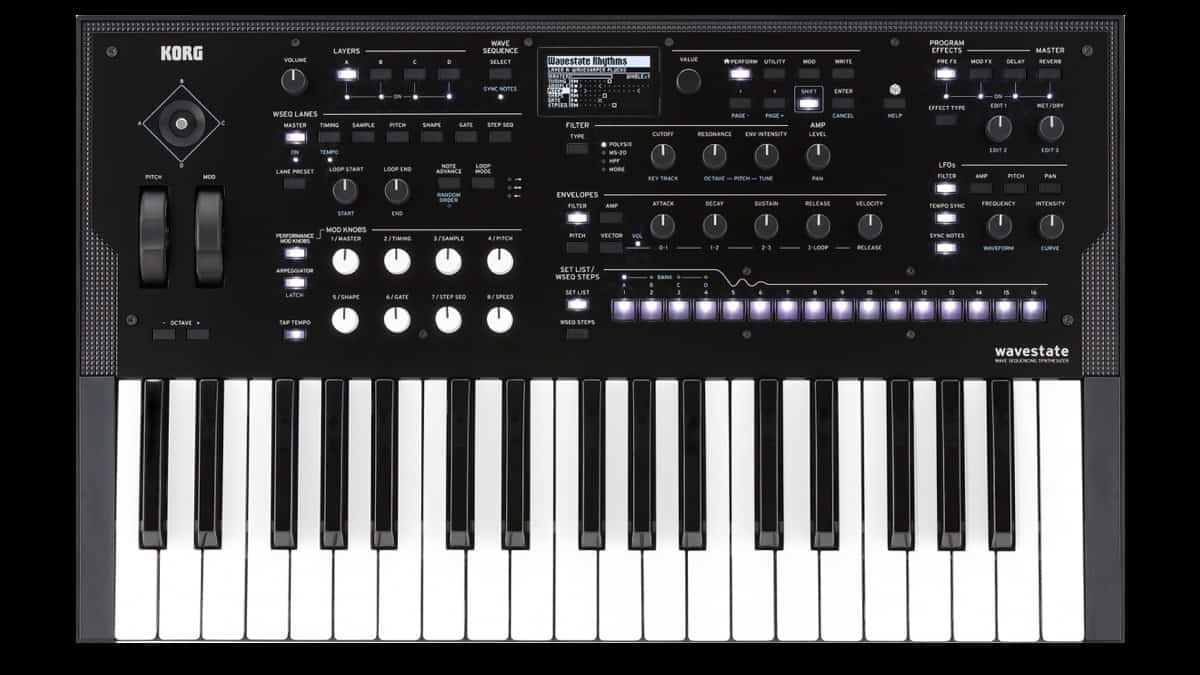In This Issue
Korg Wavestate Sequencing Synthesizer: Exclusive Synth and Software Review

Korg’s compact reissue of the ’90s classic packs a powerful punch. Mark Jenkins rides its waves.
The Wavestate is one of a pair of lightweight, compact 3-octave synths launched by Korg, the other being the opsix (review published here earlier this week). Yet to come is the Modwave (featured in this year’s Believe in Music report), based on sound creation techniques of the DW8000 synth from the 1980s, while opsix is derived from the Yamaha DX7’s FM synthesis design, and Wavestate from that of the original Korg Wavestation and its two module versions.
“Wave Sequencing Synthesis” as found on the Wavestate is fairly rare. The PPG Wave keyboards from Germany introduced wavetable synthesis, sweeping through a bunch of digital waveforms during the course of a note. Choose fairly similar waveforms and you get a smooth sound, maybe resembling an analog filter closing down (though the PPG offered real analog filters too). The Prophet VS from Sequential introduced Vector Synthesis. It swept through different waves by recording the movements of a joystick as it mixed between four different waveforms.
The original early 1990s Wavestation, and now the Wavestate, differ slightly from either of these ideas. On these instruments the plan is to choose very dissimilar waves and play them in an endless cycle, creating something between a melodic sequence and a drum pattern.
Wavestation patterns were originally not very easy to edit and modify, but the new Wavestate changes all that by offering no fewer than 25 variable controls as well as a joystick and pitchbend/modulation wheels, all in a compact, plastic chassis instrument weighing only a few pounds.

16 buttons (times four banks) allow favorite sounds to be organized, while an endless dial and a luminescent display offer many more. And many versions of old Wavestation favourites are there – the cyclical “Ski Jam,” for example, which singlehandedly created a quick cue for many a 1990s movie composer.
And this is one forte of the Wavestate. Sounds are now in four layers, and the awesome complexity of many creates a complete soundtrack piece or intro texture needing barely any additions. As the wave sequence plays, you can: highlight different parts with the joystick; make loops run backwards and forwards; filter a chosen part with a Korg Polysix, Korg MS20 Lowpass or Highpass, and many more types of filter; mix in effects levels including a huge reverb, delays, distortion; and much more.

However, the Wavestate isn’t a one-trick pony. The sounds that don’t cycle are rich and smooth too, so there are perfectly impressive strings, pianos, multi-layered pads, and much more.
Octave +/- buttons compensate for the short keyboard, and MIDI In/Out sockets join USB for external interfacing.
The four edit knobs to the right allow the adjustment of two effects parameters at a time, as well as applying LFOs to the filter, amplitude, pitch, and pan of the current sound. Eight white “Mod Knobs” really dig into the essence of a wave sequence, allowing the nature and pitch of each sample in a wave sequence to be edited.
Wave sequence patterns, or “lanes,” can be created from scratch, modified from existing ones, or completely randomized using a “Cube” button. Many of the presets include exciting flourishes such as the “ratcheting” effect often added to sequences by synth bands like Tangerine Dream.
The Wavestate isn’t only going to appeal to synth bands, though. Apart from being an awesome ambient/soundtracking instrument, it has some strong techno/dance style patterns to offer, loads of repetitive/minimalist music material, screaming solo sounds for prog rock use, and much more.

As for programming new sounds… well, it’s still not all that simple. Certainly presets can be modified quickly, but the vast potential of the Wavestate means that starting a sound from scratch may be a long journey down a deep rabbit hole.
In conclusion, though, those who heard the old Wavestation in the 1990s are going to find part of the Wavestate’s abilities very familiar, but should welcome the innovations in design.
Those who missed the original may be stunned by what the Wavestate can do. Prepare for a whole slew of movie soundtrack material consisting of little more than a single Wavestate factory sound.
Price: $699 http://www.korg.com/us/

















